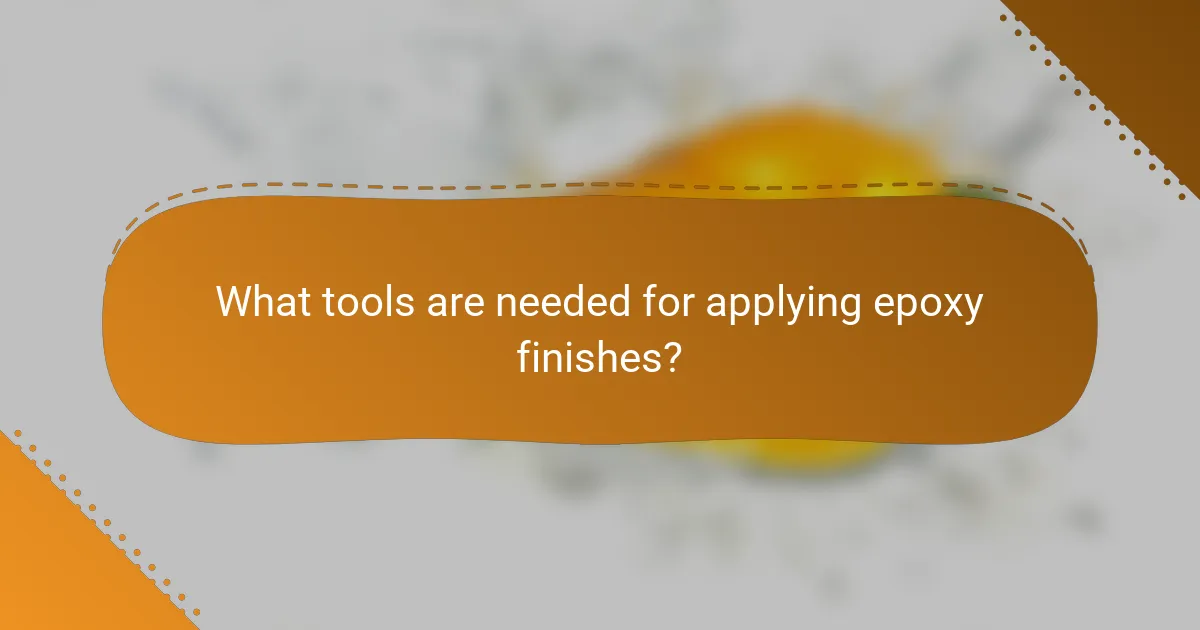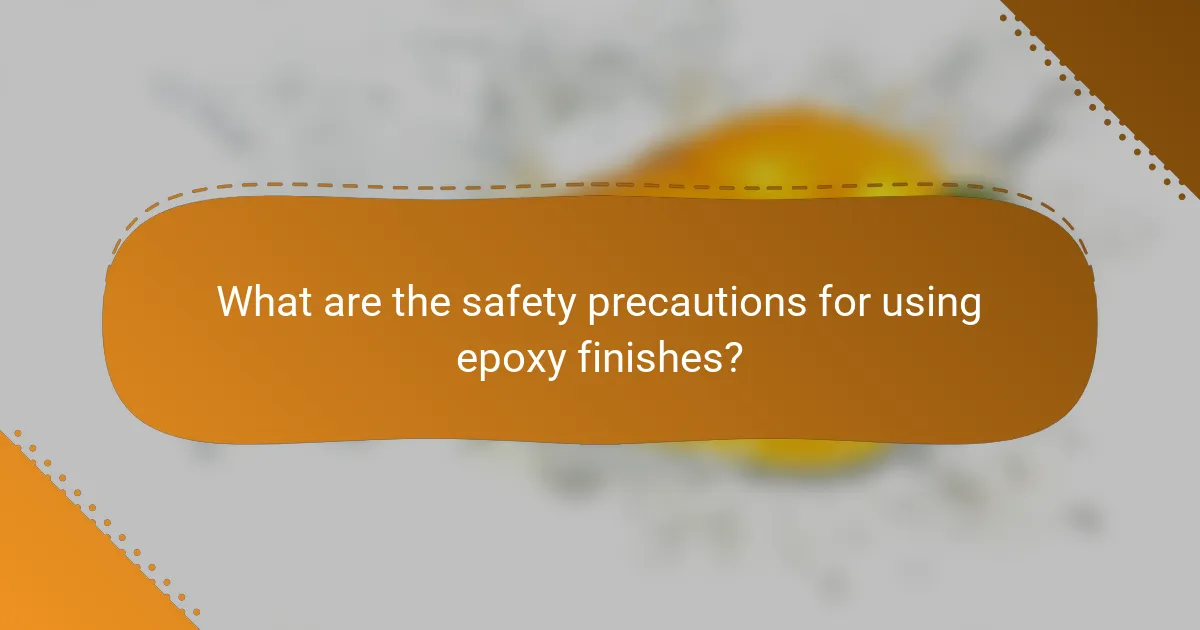Epoxy finishes are essential for enhancing the durability and aesthetic appeal of resin crafts, and selecting the appropriate application method is key to achieving the desired results. Techniques such as brushing, rolling, spraying, pouring, and dip coating each offer unique benefits, making it important to consider the specific needs of your project. Proper surface preparation and the use of the right tools further contribute to a smooth, professional finish.

What are the best application methods for epoxy finishes in resin crafts?
The best application methods for epoxy finishes in resin crafts include brush, roller, spray, pouring, and dip coating techniques. Each method has its own advantages and considerations, making it essential to choose the right one based on the project requirements and desired finish.
Brush application
Brush application is ideal for detailed work and smaller projects where precision is key. Use a high-quality brush to apply the epoxy evenly, ensuring that you cover all surfaces without leaving bubbles. This method allows for better control, especially in intricate designs.
When using a brush, work in thin layers to avoid drips and runs. A common pitfall is applying too much epoxy at once, which can lead to uneven surfaces. A good practice is to keep a wet edge while working to maintain a smooth finish.
Roller application
Roller application is effective for larger surfaces, providing a smooth and even coat. Use a foam roller for best results, as it minimizes bubbles and allows for quick coverage. This method is particularly useful for tabletops or larger art pieces.
To achieve the best finish, apply the epoxy in thin layers and avoid overworking the surface. Rollers can sometimes leave texture, so consider using a fine roller for a smoother result. Ensure the workspace is free from dust to prevent imperfections.
Spray application
Spray application offers a quick and efficient way to apply epoxy finishes, especially on complex shapes or large areas. Using a spray gun can help achieve a fine mist, resulting in an even coat without brush marks.
However, this method requires proper ventilation and safety precautions due to fumes. It’s essential to practice on a test piece to adjust the spray pattern and pressure before applying it to the final project. Keep the spray distance consistent to avoid uneven application.
Pouring technique
The pouring technique is popular for creating a thick, glossy finish, particularly in river tables and artwork. This method involves pouring the epoxy directly onto the surface and spreading it evenly with a spatula or similar tool.
To prevent bubbles, heat the epoxy slightly before pouring, and work in a warm environment. It’s crucial to pour in layers if a thicker finish is desired, allowing each layer to cure before adding the next. Be mindful of the epoxy’s working time to avoid premature curing.
Dip coating
Dip coating is a unique method where the item is submerged in epoxy, providing a uniform finish. This technique is suitable for smaller objects and can create a thick, durable layer of epoxy.
Ensure the item is clean and free from contaminants before dipping. After dipping, allow excess epoxy to drip off and cure in a controlled environment. This method can be less common but is effective for achieving a consistent coating on intricate shapes.

How to prepare surfaces for epoxy finishes in resin crafts?
Preparing surfaces for epoxy finishes in resin crafts involves thorough cleaning and proper priming to ensure optimal adhesion and a smooth finish. This process is crucial for achieving durable and aesthetically pleasing results.
Cleaning and sanding
Start by cleaning the surface to remove any dust, grease, or contaminants that could interfere with the epoxy bond. Use a mild detergent solution and a lint-free cloth for this purpose. After cleaning, sanding the surface is essential to create a rough texture that enhances adhesion.
When sanding, aim for a grit between 80 and 120 to effectively scuff the surface without damaging it. Be sure to wipe away any dust created from sanding before applying the epoxy to ensure a clean bonding area.
Priming surfaces
Priming surfaces before applying epoxy can significantly improve adhesion, especially on porous materials like wood or concrete. Use a suitable primer that is compatible with epoxy resin, and apply it evenly according to the manufacturer’s instructions.
Allow the primer to dry completely before proceeding with the epoxy application. This step is particularly important in humid conditions, where drying times may vary. A well-primed surface will help prevent issues like bubbling or peeling in the finished epoxy layer.

What tools are needed for applying epoxy finishes?
Applying epoxy finishes requires specific tools to ensure a smooth and even application. The right tools can significantly impact the final appearance and durability of the resin crafts.
Brushes and rollers
Brushes and rollers are essential for applying epoxy finishes, especially on smaller or detailed surfaces. A high-quality brush can help achieve a smooth finish, while rollers are ideal for larger areas, allowing for quicker application. Choose brushes with synthetic bristles to avoid shedding and ensure even coverage.
When using rollers, opt for a foam roller for a smoother finish, and consider the nap length based on the surface texture. A short nap is suitable for flat surfaces, while a longer nap can help fill in imperfections on rougher textures.
Spray equipment
Spray equipment offers a fast and efficient way to apply epoxy finishes, particularly for large projects. Airless sprayers or HVLP (high volume low pressure) sprayers can provide a fine mist that covers surfaces evenly without leaving brush marks. However, they require careful setup and may need more practice to master.
When using spray equipment, ensure you are in a well-ventilated area and wear appropriate safety gear, such as a mask and goggles. Adjust the spray pattern and pressure to achieve the desired finish, and practice on a scrap piece before applying it to your project.
Mixing tools
Mixing tools are crucial for preparing epoxy finishes, as proper mixing ensures the resin and hardener combine effectively. Use a clean, disposable mixing cup and a stir stick to blend the components thoroughly, following the manufacturer’s recommended mixing ratio.
Consider using a power mixer for larger batches to save time and ensure a consistent mixture. Avoid mixing too quickly, as this can introduce air bubbles, which may affect the final finish. Always mix in a well-ventilated area to minimize exposure to fumes.

What are the common mistakes to avoid when applying epoxy finishes?
Avoiding common mistakes when applying epoxy finishes can significantly improve the quality of your resin crafts. Key pitfalls include improper mixing ratios, skipping surface preparation, and ignoring temperature and humidity conditions.
Improper mixing ratios
Using incorrect mixing ratios of resin and hardener is a frequent mistake that can lead to issues like incomplete curing or a sticky surface. Always follow the manufacturer’s guidelines, which typically recommend a specific ratio, often around 1:1 or 2:1 by volume.
To ensure accuracy, use a scale for weighing components or graduated mixing cups for measuring. A simple way to remember is to mix small batches first to test the outcome before committing to larger projects.
Skipping surface preparation
Surface preparation is crucial for achieving a strong bond between the epoxy and the substrate. Failing to clean, sand, or prime the surface can result in poor adhesion and eventual peeling or bubbling.
Before applying epoxy, clean the surface thoroughly to remove dust, grease, or moisture. Lightly sanding the area can create a better grip for the epoxy, enhancing durability and finish quality.
Ignoring temperature and humidity
Temperature and humidity levels can greatly affect the curing process of epoxy finishes. Ideally, the application should occur in a controlled environment, typically between 20°C and 25°C (68°F to 77°F) with low humidity levels.
High humidity can lead to cloudiness or improper curing, while low temperatures may slow down the hardening process. Always check the product specifications for optimal conditions and consider using a heater or dehumidifier if necessary.

What are the safety precautions for using epoxy finishes?
When using epoxy finishes, safety precautions are essential to prevent health risks and ensure a safe working environment. Key measures include wearing personal protective equipment and ensuring proper ventilation during application.
Personal protective equipment
Wearing appropriate personal protective equipment (PPE) is crucial when working with epoxy finishes. This typically includes gloves, safety goggles, and a respirator to protect against skin contact, eye irritation, and inhalation of fumes.
Choose gloves made from nitrile or neoprene, as these materials resist chemical penetration. Ensure that safety goggles are rated for chemical exposure, and use a respirator with organic vapor cartridges in poorly ventilated areas.
Ventilation requirements
Proper ventilation is vital when applying epoxy finishes to minimize exposure to harmful fumes. Work in well-ventilated spaces, ideally with cross-ventilation, to allow fresh air to circulate and disperse vapors.
If working indoors, consider using exhaust fans or opening windows and doors to enhance airflow. For larger projects, a dedicated ventilation system may be necessary to maintain safe air quality levels.

How to achieve a glossy finish with epoxy?
To achieve a glossy finish with epoxy, proper mixing, application, and curing techniques are essential. A smooth surface and the right environmental conditions significantly enhance the final appearance of your resin crafts.
Preparation of the surface
Surface preparation is crucial for a glossy epoxy finish. Start by cleaning the surface thoroughly to remove dust, grease, or contaminants. Sanding the surface lightly can help the epoxy adhere better, creating a smoother finish.
Ensure that the surface is dry and free from moisture, as this can affect the curing process. If working with wood, sealing any porous areas with a primer can prevent bubbles and improve the overall sheen.
Mixing the epoxy
Mixing epoxy correctly is vital for achieving a glossy finish. Follow the manufacturer’s instructions for the correct resin-to-hardener ratio, usually around 1:1 or 2:1 by volume. Use a clean mixing container and stir slowly to minimize air bubbles.
Consider using a heat gun or torch to gently pass over the mixed epoxy to eliminate any trapped bubbles before application. This step can enhance the clarity and glossiness of the final product.
Application techniques
For a glossy finish, apply the epoxy using a brush, roller, or pouring method, depending on the project. Pouring is often the best technique for larger surfaces, as it allows for a self-leveling effect that minimizes imperfections.
Work in thin layers, allowing each layer to cure fully before applying the next. This approach helps prevent issues like sagging or unevenness, which can detract from the glossy appearance.
Curing conditions
Curing conditions play a significant role in achieving a glossy finish. Ideally, epoxy should cure in a warm, dust-free environment with stable temperatures, typically between 20-25°C (68-77°F). Avoid high humidity, as this can lead to cloudiness.
Allow the epoxy to cure for the recommended time, which can range from several hours to a few days, depending on the product. Patience during this stage is essential for ensuring a durable and glossy finish.


